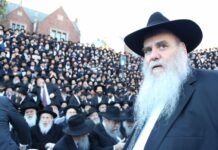An ironic aspect of the Chazon Ish’s influence on klal Yisrael is that although he shied away from leadership his entire life, he impacted scores of Yidden all over the world; today, thousands are known as “Chazon Ishniks.” While there have been many gedolim whose psakim are still adhered to decades after their passing, there are few whose communities adhere exclusively to their psakim. Nowhere is the impact of the Chazon Ish as evident as in Bnei Brak, a city that he is credited with developing into the Torah fortress that it is today. As I walk around Bnei Brak, I am struck by just how strongly evident the Chazon Ish’s imprint is today, with hundreds of bnei Torah walking around in Chazon Ishnik-style garb. Chug Chazon Ish, as the community is more commonly referred to, is known for the way its members are stringent in every aspect of halachah, following in the Chazon Ish’s way.
Last Living Nephew
The Chazon Ish, Rav Avraham Yeshaya Karelitz, did not leave any children. His legacy is his sefarim and his talmidim, many of whom have become gedolim in their own right. There are not many people still alive today who had a meaningful relationship with the Chazon Ish. Aside from Rav Meir Tzvi Bergman, Rav Dov Landau, and Rav Yudel Bauer, few of his disciples are still with us. One of the Chazon Ish’s sisters married Rav Shmuel Greinemann, founder of the Vaad Hayeshivos in Vilna as well as the Merkaz Chinuch HaTorah in Eretz Yisrael. His children, the Chazon Ish’s nephews, became some of his prime disciples. Rav Chaim Greinemann, zt”l, mechaber of the Chiddushim U’Biurim sefarim and a world-renowned gadol, was the best known of his nephews. After the passing of Rav Chaim Kanievsky, Rav Meir Greinemann is the only surviving nephew of the Chazon Ish and the de facto leader of the community. Rav Meir, the longtime rosh kollel in Ohr Akiva and author of the Imrei Yosher sefarim on the entire Shas, did shimush by the Chazon Ish for the last six years of his life and modeled his sefarim after the style of his saintly uncle. Rav Meir compiled halachos, hanhagos, and minhagim that he observed while serving his saintly uncle and printed them in his Sefer Dinim V’Hanhagos MiMaran Chazon Ish. It is because of his unique and intimate view of the Chazon Ish that I am sitting in his third-floor apartment today.
Rav Meir’s apartment is sparsely furnished, with almost no home decor. The few items of furniture are mismatched: There are a few different kinds of chairs, two dining room tables that are not totally aligned, and different-colored cabinets. The bookshelves are sagging, burdened by the weight of many sefarim. Most of these sefarim are well-worn, their spines fraying, the pages loose.
Sitting at the head of the table, Rav Meir is in the middle of reciting Birkas Hamazon, his face contorted in concentration, each word enunciated slowly, clearly and carefully. In front of him is a large handwritten note that says “Reminder to bentch.” After he finishes, Rav Meir gives me a warm welcome, apologizing for not rising for his guests. “At my age, it is difficult,” he says with a smile.
To read more, subscribe to Ami





















